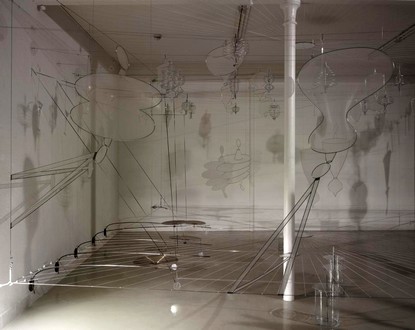In order to perpetuate Cocteau’s experimental spirit, the museum dedicated to him in Menton invites contemporary artists to physically and poetically take over the temporary exhibition space to set up their studios. After Jean Sabrier inaugurated the museum’s temporary exhibition space in November 2011, it is now Bernard Moninot’s turn to offer four installations and several series of drawings in a scenography specially designed for the building.
What is Cocteau’s style? Due to his insatiable thirst for freedom, his refusal of limits, and his constant search for new forms of creation, Jean Cocteau has often been described as a “genius jack of all trades.” Author of poetry, drawings, prints, paintings, ceramics, tapestries, theatre, and even “free films,” he can rightly be considered one of the first multimedia artists of the 20th century.
In this spirit, the Musée Cocteau de Menton regularly opens its doors to numerous artists to showcase the birth of an idea, a form, the experimentation of a gesture, and to highlight an atelier practice, in the pure tradition of the artist.
Bernard Moninot, who has been practicing drawing and engraving since 1970, can be considered a true heir to Cocteau. Through the exhibition “Drawings in Space,” he invites us to dive into his dreamlike universe.
This exhibition was born from a dream: in 2009, during a dream, Bernard Moninot visited the studio of an unknown artist whose major work was a “sculpture of silence.” The studio was entirely empty. Upon waking, he decided to give form to this poetic idea and create this impossible work. Over several years, he systematically drew combinations of forms evoking sound and silence in sketchbooks. These drawings, made on paper, are then transposed into space, in three dimensions, as three installations that represent successive stages of this exploratory work.
“Studiolo,” is a drawing with shadows cast on a wall created by the effect of light passing through a drawing plane made of steel cables, piano wires, and plexiglass. An ingenious way to reveal invisible phenomena through observation and measurement tools.
“Objects of Silence” is a first attempt at a visual representation of silence. Sonograms (the image of a signal in a frequency-intensity representation) of the word “silence” are highlighted with piano wire and enclosed in glass vases. These objects are presented in a chamber of translucent silk.
The third installation, “Silent-Listen,” is a drawing in space, consisting of objects like cymbals, magnetic tape, tuning forks, and representations of sonograms, whose shadows envelop the surrounding walls.
Finally, “Antichamber” is a suspended work that rotates on itself like a satellite launched into space, which has no other function than the appearance, elongation, deformation, and disappearance of the shadows and reflections it generates.
These three works of silence are presented in a scenography designed by the artist using translucent screens stretched along the window bays, creating large shadow tableaux. They unfold in the three dimensions of the chamber, the studio, or the museum, also bearing witness to the artist’s fascination with astronomy.
These three installations are accompanied by several series of large-format two-dimensional drawings questioning our perception of space, from the infinitely small to the infinitely large, and the optical illusion phenomena inherent to certain materials, such as silk and glass.


